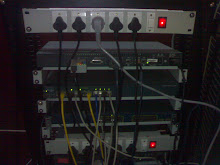Cisco Command Line interface (CLI)
The router will allow us to type commands but in different modes we can only used specific commands. So in this tutorial we will learn about the Command Line Interface (CLI) and different modes in a Cisco router/switch.
Below lists popular modes in Cisco switch/router:
Router> User mode
Router# Privileged mode
Router(config)# Configuration mode
Router(config-if)# Interface level (within configuration mode)
Router(config-router)# Routing engine level (within configuration mode)
Router(config-line)# Line level (vty, tty, async) within configuration mode
Now let’s discuss each mode in more detail
User mode (Unprivileged mode)
In most case this is the mode you will see on the screen after connecting to it. This mode provides limited access to the router. You are provided with a set of nondestructive commands that allow examination of certain router configuration parameters (mostly to view statistics). You cannot, however, make any changes to the router configuration.
Privileged mode
Also known as the Enabled mode, this mode allows greater examination of the router and provides a more robust command set than the User mode. In Privileged mode, you have access to the configuration commands supplied in the Global Configuration mode, meaning you can edit the configuration for the router.
Configuration mode
Also called the Global Configuration mode, this mode is entered from the Privileged mode and supplies the complete command set for configuring the router. In this mode you can access interface level, routing engine level, line level…
Interface level
In some books, this level is also referred as “interface configuration mode” or “interface mode”. In fact, it is a level inside Configuration mode so you can see the “configuration” part in its prompt (config-if). This level can be accessed by typing a specific interface in Configuration mode. For example:
Router(config)#interface fa0/0
Router(config-if)#
But notice that the prompt doesn’t give you information about which interface is being configured so be careful with this level while you are configuring! This lack of information can make you configure wrong interface easily!
Routing engine level
This is the level where we configure dynamic routing protocols (RIP, OSPF, EIGRP…). You will learn about them later in CCNA.
Line level
In this level we can configure Telnet, Console, AUX port parameters. Also notice that the prompt (config-line) is used for all “lines” on the router so you must be careful about which line you are configuring!
Note: The “line” here can be a physical Console port or a virtual connection like Telnet.
The router will allow us to type commands but in different modes we can only used specific commands. So in this tutorial we will learn about the Command Line Interface (CLI) and different modes in a Cisco router/switch.
Below lists popular modes in Cisco switch/router:
Router> User mode
Router# Privileged mode
Router(config)# Configuration mode
Router(config-if)# Interface level (within configuration mode)
Router(config-router)# Routing engine level (within configuration mode)
Router(config-line)# Line level (vty, tty, async) within configuration mode
Now let’s discuss each mode in more detail
User mode (Unprivileged mode)
In most case this is the mode you will see on the screen after connecting to it. This mode provides limited access to the router. You are provided with a set of nondestructive commands that allow examination of certain router configuration parameters (mostly to view statistics). You cannot, however, make any changes to the router configuration.
Privileged mode
Also known as the Enabled mode, this mode allows greater examination of the router and provides a more robust command set than the User mode. In Privileged mode, you have access to the configuration commands supplied in the Global Configuration mode, meaning you can edit the configuration for the router.
Configuration mode
Also called the Global Configuration mode, this mode is entered from the Privileged mode and supplies the complete command set for configuring the router. In this mode you can access interface level, routing engine level, line level…
Interface level
In some books, this level is also referred as “interface configuration mode” or “interface mode”. In fact, it is a level inside Configuration mode so you can see the “configuration” part in its prompt (config-if). This level can be accessed by typing a specific interface in Configuration mode. For example:
Router(config)#interface fa0/0
Router(config-if)#
But notice that the prompt doesn’t give you information about which interface is being configured so be careful with this level while you are configuring! This lack of information can make you configure wrong interface easily!
Routing engine level
This is the level where we configure dynamic routing protocols (RIP, OSPF, EIGRP…). You will learn about them later in CCNA.
Line level
In this level we can configure Telnet, Console, AUX port parameters. Also notice that the prompt (config-line) is used for all “lines” on the router so you must be careful about which line you are configuring!
Note: The “line” here can be a physical Console port or a virtual connection like Telnet.

No comments:
Post a Comment